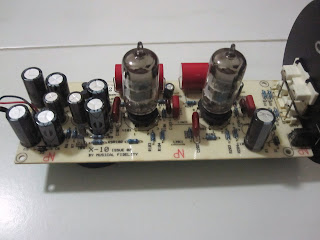Heard my 1st Onix amp in 1988, a OA-20. Should have bought it then...
 |
| Front |
 |
| Slant view |
More than 20 years later, chance upon a OA-20/2 in good working condition - not making the same mistake twice!
The Onix deserve it's well earn reputation of a great performing unit with grunt- an excellent example of British audio quality. Although rated at a lowly 30W RMS and weight a mere 4kg, it is no push over. The unit was hardly warm after running for a few hours with the volume at 7 o'clock. This was more than enough to drive my honeycombs to a decent volume in a room 30ftx20ft.
After warm-up, the Onix was revealing. The mid and HF was fluid when playing a CD of well recorded piano pieces. Bass could be better but acceptable, may consider a recap later on (since it has been over 20 years).
 |
| Top |
 |
| Back |
 |
| Component view from back |
Little wonder these units are seldom available in the resale market. And are quickly snapped up when they became available!
Update - 30Jul2011
Finally decided to perform maintenance on the electrolytic capacitors in the power amplifier section, as the reproduction seem a little muddle on critical passages.
Upon closer inspection, notice the unit had been repaired before and a unknown brand of EC, "Sun" was used in the power rectifier section as well as one side of the power amplifier. Replaced the 100uf 10V with Panasonic FC and the original 4.7uf 50V with Panasonic ECA of equal values in the power amp section. Left the Sun EC in the power rectifier section as that should be adequate for the task. Using better quality EC and substituiting the pairs of EC in the power amp section provided the desired results. Source is the
Sony CDP-333ESA which is now connected directly to the Onix without the tube buffer. The Onix is now driving my
Mission 753 Freedom's via 1.5m of the original QED Silver Anniversary (with enough silver to cover most of the cable diameter).
 |
| Original amp section |
 |
| Capacitors replaced from power amp section |










